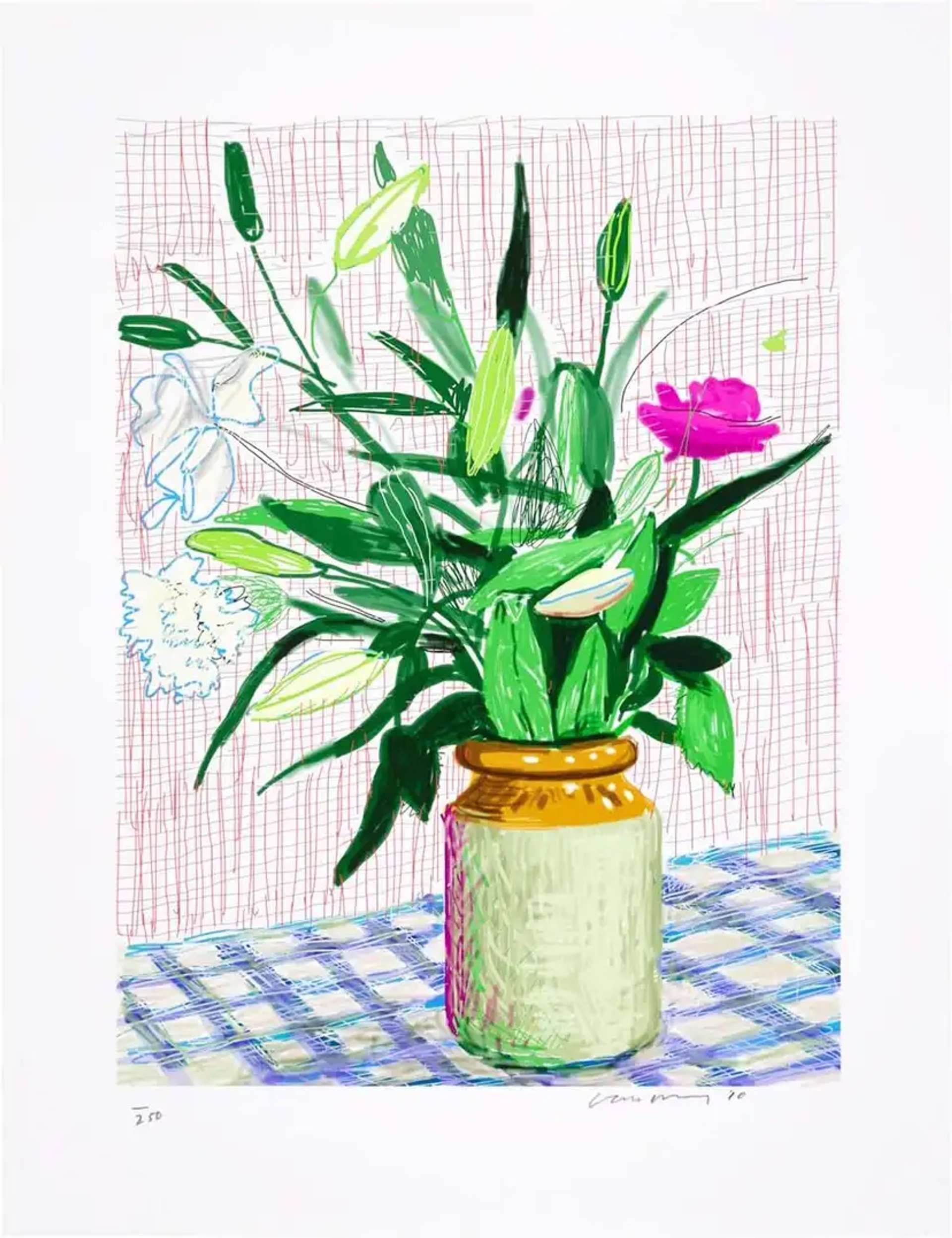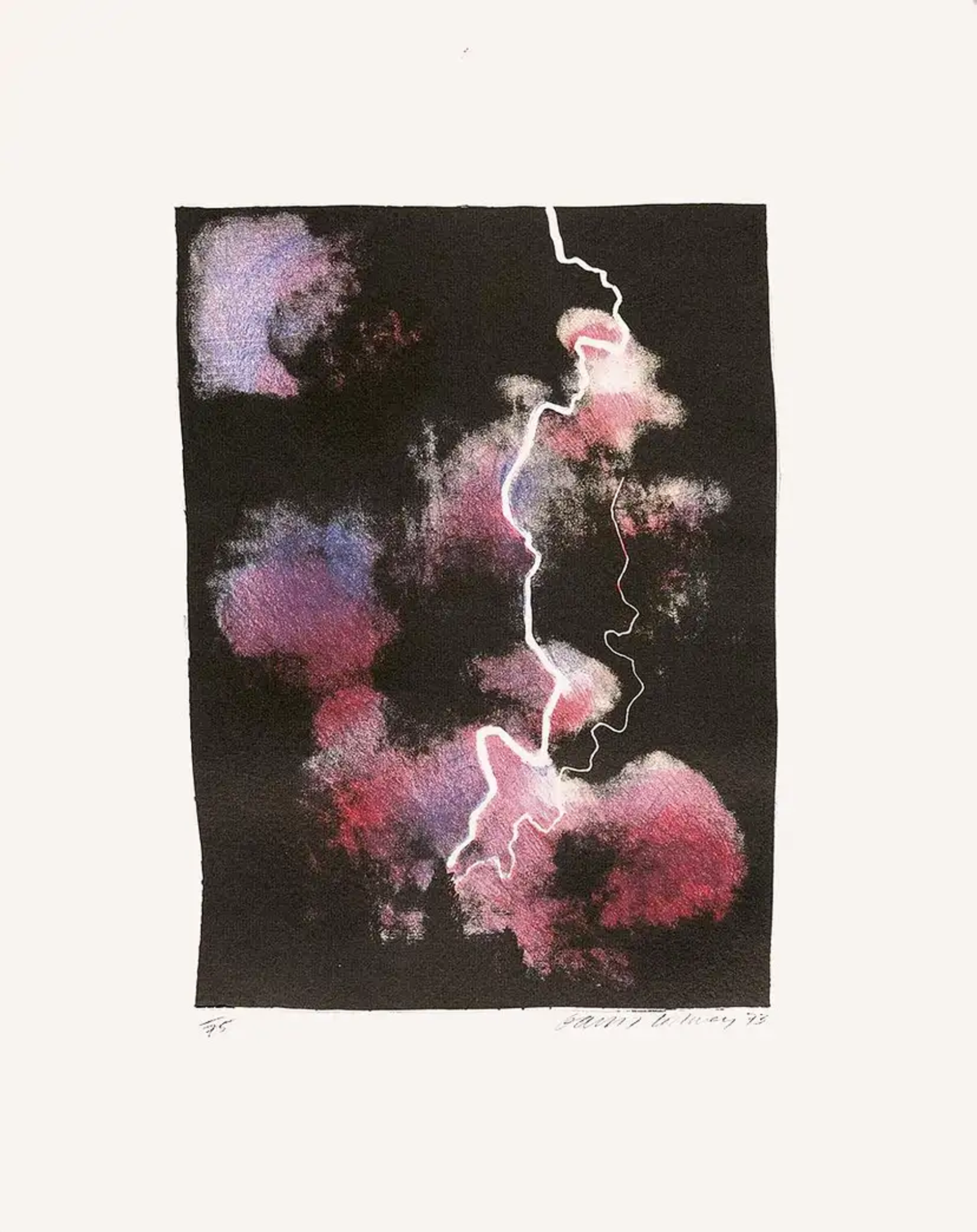En Plein Air: The Impressionists' Influence on David Hockney's Art

 The Arrival Of Spring In Woldgate East Yorkshire 21st March 2011 © David Hockney 2011
The Arrival Of Spring In Woldgate East Yorkshire 21st March 2011 © David Hockney 2011
David Hockney
651 works
The Impressionist movement forever altered the trajectory of art history. Characterised by its exploration of light, colour and the transient nature of the world, Impressionism challenged traditional academic norms and celebrated the beauty of the everyday. Over a century later, its legacy continues to thrive, inspiring contemporary artists to explore similar themes in their own unique ways. This is evident in the work of the renowned artist David Hockney, who is celebrated for his versatile and innovative oeuvre; while Impressionist principles have left a clear mark on his artistic approach, he also infuses his own distinctive perspective into this timeless tradition.
 Water Lilies (W.1709) © Claude Monet 1907
Water Lilies (W.1709) © Claude Monet 1907The Impressionist Movement: A Brief Overview
The Impressionist movement emerged in late 19th-century France, and stands as a transformative chapter in the history of art; it signalled a rebellion against the rigid conventions of academic art that had dominated the art world for centuries. As a result, the early Impressionists faced rejection and ridicule from the traditional art establishment, leading them to organise their independent exhibitions where their innovative style gradually gained recognition and attracted a wider audience; the first of these was held in Paris in April 1874. Prominent Impressionist artists like Claude Monet, Pierre-Auguste Renoir, Camille Pissarro, Edgar Degas and Berthe Morisot each contributed their unique perspectives to the movement, enriching its diversity.
One of the defining features of Impressionism was its choice of ordinary, everyday subjects as the focus of their artworks. Whether it was landscapes, cityscapes, portraits or scenes of leisurely activities, the Impressionists celebrated the beauty found in the mundane and transient moments of life. The rise of photography in the 19th century influenced the movement, freeing artists from the sole responsibility of producing realistic representations and allowing them to experiment with more subjective and interpretive approaches. As the movement evolved, artists such as Monet delved deeper into their exploration of light and color. The Impressionist legacy extended far beyond their immediate circle, influencing subsequent art movements, including Post-Impressionism, Fauvism and the development of modern Abstract art. Today, the Impressionist movement remains pivotal and enduring in the world of art, celebrated for its emphasis on the subjective experience of the artist and its transformative impact on artistic expression.
 Claude Monet Painting in His Garden at Argenteuil © Pierre-Auguste Renoir 1873
Claude Monet Painting in His Garden at Argenteuil © Pierre-Auguste Renoir 1873En Plein Air, Colour and Light: Impressionist Techniques
At its core, Impressionism was characterised by a profound fascination with the interplay of light and colour in the natural world. Impressionist artists aimed to capture the ephemeral effects of light and atmosphere, and their distinctive technique involved loose and visible brushwork – employing small distinct brushstrokes to convey an overall sense of colour and ambiance, rather than intricate details. They often ventured outside to paint en plein air in order to observe the fleeting changes of nature firsthand. This innovative approach marked a departure from the studio-bound traditions of their predecessors and allowed Impressionists to directly respond to the ever-changing nuances of their surroundings. Painting en plein air was a revolutionary choice: this practice enabled them to capture the immediate and transient qualities of the scenes they depicted, whether it was the shifting colours of a sunset, the dappled light filtering through trees or the play of sunlight on water. By painting on location, they were able to immerse themselves in the atmosphere and imbue their works with a sense of spontaneity and authenticity that was often lacking in a studio setting.
Also central to the Impressionist technique was the understanding that colour is dynamnic rather than static, influenced by atmospheric conditions. Impressionist artists explored the vibrancy and variability of colour in their works, emphasising the importance of contrasting hues, juxtapositions and optical mixing. They realised that by placing complementary colours side by side, they could create a more vivid and vibrant visual experience as opposed to blending paints on the palette. As keen observers of natural light, they paid meticulous attention to the shades that emerged at different times of the day and under varying weather conditions. For instance, they noted how the quality of light at dawn differed from that at midday, resulting in unique scenes. By capturing these subtle variations, Impressionists were able to convey the essence of a moment in time.
The Impressionist techniques were all instrumental in achieving their goal of capturing the fleeting moments of beauty and atmosphere in the natural world. These defined the Impressionist movement while having a lasting influence on the development of modern art, emphasising the importance of perception, sensation and the artist's personal experience in the creative process.
David Hockney: A Modern Master
Hockney is a towering figure in the world of contemporary art, celebrated for his innovative and versatile body of work that spans painting, drawing, printmaking, photography and even digital art. Born in 1937 in Bradford, England, Hockney's artistic journey has earned him great success and the status of a modern master. His artistic talent became evident at a young age as he pursued his passion for art at the Royal College of Art in London. It was during this time that he developed a unique and distinctive style that would set him apart from his contemporaries. In the 1960s, Hockney gained international recognition for his association with the Pop Art movement. He moved to Los Angeles, California, where he was inspired by the vibrant culture, sunny landscapes and poolside scenes of Southern California.
One of Hockney's defining characteristics as an artist is his mastery of colour and composition. He has an uncanny ability to capture the essence of a scene or a subject through his palette, often employing bold and contrasting vibrant hues. His exploration of space is equally remarkable, as he plays with perspective to create visually engaging and thought-provoking artworks. Hockney's versatility is another hallmark of his career as he has consistently pushed the boundaries of traditional art mediums, embracing new technologies and techniques. His experiments with photography and collage in the 1980s and his later foray into digital art, created using devices like the iPad, demonstrate his willingness to adapt and innovate.
Hockney's impact on contemporary art is immeasurable. His work continues to inspire and captivate audiences around the world, and he is one of the most successful living artists of our time. Hockney's willingness to challenge artistic conventions and embrace new technologies has set a precedent for future generations, illustrating that the essence of being a modern master lies in the ability to evolve and adapt while staying true to one's unique vision.
The Influence of Impressionism on Hockney's Work
Hockney has drawn inspiration from a wide range of artistic movements and styles throughout his career. Among these influences, Impressionism holds a significant place, particularly in shaping his approach to colour, light and the depiction of the natural world. The Impressionist fascination with the ever-changing quality of light and its impact on colour is a theme that Hockney has seamlessly incorporated into his work – his early exposure to Impressionist works during his formative years in art school left a lasting impression. Hockney has adopted the Impressionist technique of painting en plein air, which allows him to observe and respond to the nuances of the natural world. This approach is particularly evident in his landscape paintings, where he skillfully recreates the vibrant interplay of light on water, the shifting hues of the seasons and the luminous qualities of the California sun, reminiscent of Impressionist depictions of nature. Hockney has also embraced their use of loose and visible brushwork, often employing small, distinct brushstrokes in his paintings. His brushwork, like that of the Impressionists, allows viewers to see the individual marks and strokes, inviting them to engage with the painting's surface and appreciate the artist's creative process.
The influence of Impressionism on Hockney's work is unmistakable. His keen appreciation for the effects of colour and light, the use of visible brushwork and his interpretation of landscapes and portraiture all bear the mark of Impressionist principles. However, Hockney doesn't merely mimic the past but rather integrates these influences into his distinctive style, creating a body of work that pays homage to the Impressionists while maintaining its own modern and timeless appeal. This synthesis of tradition and innovation is a testament to Hockney's status as a modern master in the art world.
The Legacy of Impressionism in Contemporary Art
As we have seen, Impressionism has left an enduring legacy that continues to influence contemporary artists in profound ways. The principles and techniques championed by Impressionist painters have transcended time and continue to resonate with artists who seek to capture the essence of the fleeting and the transient in their work. Hockney, a prominent figure in contemporary art, serves as a prime example of an artist who has drawn inspiration from Impressionism while infusing his unique perspective into the tradition. The movement’s emphasis on the exploration of light, colour and the subjective experience of the artist challenged the academic traditions of its time, and its commitment to depicting the ordinary and the ephemeral – rather than rigidly adhering to classical standards – paved the way for a new era of artistic expression.
Hockney has openly acknowledged the influence of Impressionism on his work. His fascination with the play of light, the vibrant interplay of hues and the transient qualities of the natural world all bear the unmistakable mark of Impressionist principles. Hockney's early exposure to Impressionist paintings during his art education and his subsequent adoption of the en plein air technique reflect his deep appreciation for the movement. Hockney's landscape paintings, whether depicting the radiant landscapes of California or the picturesque Yorkshire landscapes, often evoke the spirit of Impressionism. He masterfully captures the ever-changing qualities of light and atmosphere, using bold brushwork and vivid tones to convey the dynamic beauty of his natural surroundings.
The legacy of Impressionism in contemporary art extends beyond Hockney to encompass a wide range of artists who have embraced its principles. While Hockney's work is a notable example of this influence, many contemporary artists have incorporated Impressionist techniques into their practice, adapting and reimagining them to suit their artistic visions.








